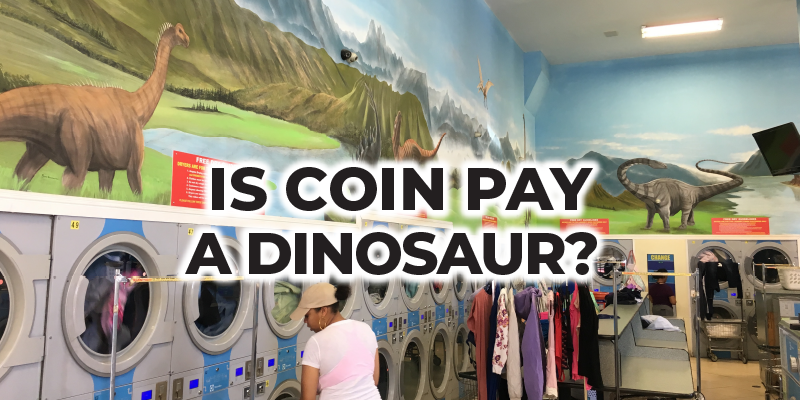Is coin pay a dinosaur?

You might be shocked to learn coin still dominates the laundromat world.
After all, how in the heck could such a progressive industry remain stuck on what many perceive as the dinosaur of pay?
Yet there it was in black and white: 76% of store operators reporting the majority of customer transactions at their washers and dryers continue to be performed with coinage — up from 67% a year earlier.
The recent polling data from Facebook’s Laundromat Owners Showcase also revealed bank cards, loyalty cards and digital grabbing the lion’s share of sales for just 12%, 9% and 3%, respectively.
We’ve seen it before. Year in, year out coin tops every self-service laundry survey conducted online or by the industry’s national association and trade magazines.
That unbroken winning streak has alternative pay proponents scratching their heads. They were confident the dinosaur would be killed off by technology.
KISS and pay
Nothing follows the laundromat’s KISS (Keep It Simple, Stupid) principle better than coins. They require no instructions or hand holding.
To be brutally honest, tech-reliant pay systems are far more sophisticated than their end users. If customers can’t figure out where the soap goes, how could anyone expect them to follow a series of prompts?
Simplicity is why coins always have wide appeal.
Ahead of the curve
We often hear the so-called dinosaur coin pay format is outmoded and hasn’t adapted to the 21st century laundromat.
I beg to differ. It stays ahead of the curve and evolves with a changing industry.
Coin-ops in 2024 aren’t circa 1944. Those nickel-and-dime storefronts from 80 years ago now host high value coinage, cashless tokens and hybrid compatibility.
The earliest manual slides and meters from inventors Mitchell Hall and Harry Greenwald were easy to use and maintain. Push-pull to wash and a flick of the wrist to dry. Fixes were just as quick.
Equipment manufacturers liked what they saw and carved out a small footprint for coin on dozens of models during the booming 1950s and ’60s.
Pay providers responded by engineering compact, versatile products where vend prices could be adjusted in seconds with a screwdriver.
Over time, lie flat single coin went multi-coin. And before those horizontal slots ran out of space everything was reconfigured vertically to maximize revenue per square inch.
Drops set the standard
While push-pull chutes and twist meters served owners well, the writing was on the wall for a new, universal workhorse — the drop coin mechanism.
Plunking in coins wasn’t a novel idea. Way back in 1961, Meter-All Manufacturing advertised a fully-automatic quarter mech with “no knobs to turn” and “to slides to push.”
The original drop-style acceptors found a home on front loaders, not the cheaper-priced top loaders.
That all changed when small chassis machines hit the dollar vend threshold. Coin pay providers were there, waiting in the wings with drops designed for the top loader’s newly-configured meter housings.
Progressive operators welcomed the opportunity to bump up every washer in the house by quarter increments.
Dryers, which had earlier moved from dime to quarter manual twist meters, eventually got on the bandwagon, paving the way for all-quarter drop operations.
Enhanced coin pay — coupled with owners embracing a higher denomination quarter — streamlined and sped up the customer experience.
Standing at a crossroads
It was just a matter of time before operators found themselves at a familiar crossroads: How to deal with fast-filling money vaults as vend prices rose.
They could either follow the natural progression to higher-value dollar coins or detour to value-added cards.
There was no middle lane. Plastic pay had kicked quarters and dollars to the curb. Owners taking the loyalty card route were forced to go coin-less.
One innovator with a proven track record in allied vended industries was ready to blaze a trail for coin.
Butch Bruner devised a way to manually take control of both low-value quarter and high-value dollar coinage rolling down the rails of a single inlet drop.
The result: A dramatic reduction in coin handling by everyone. An eight dollar vend could be satisfied with as few as eight insertions, not 32.
His Imonex drops with dual coin/token acceptance opened up a hybrid cash-cashless gateway. Owners could be their own bank by circulating an in-house currency while patrons had a new one-stop, credit card-to-token option.
Savvy operators embrace the advances in coin pay. Drops are the go-to format. Some tether add-ons so customers have the freedom to choose. Today’s modern laundromat boasts multi-coin and alt-coin.
What’s on the horizon? Rising vend prices point toward the $2 token — a higher denomination Imonex handles quite well today in markets like Australia where $2 coins circulate.
Sure sounds like that dinosaur they call coin pay isn’t on the brink of extinction.

Laurance Cohen is part of the Imonex team and welcomes inquiries on innovative payment solutions for your business.
laurance@imonex.com
(954) 999-7785

